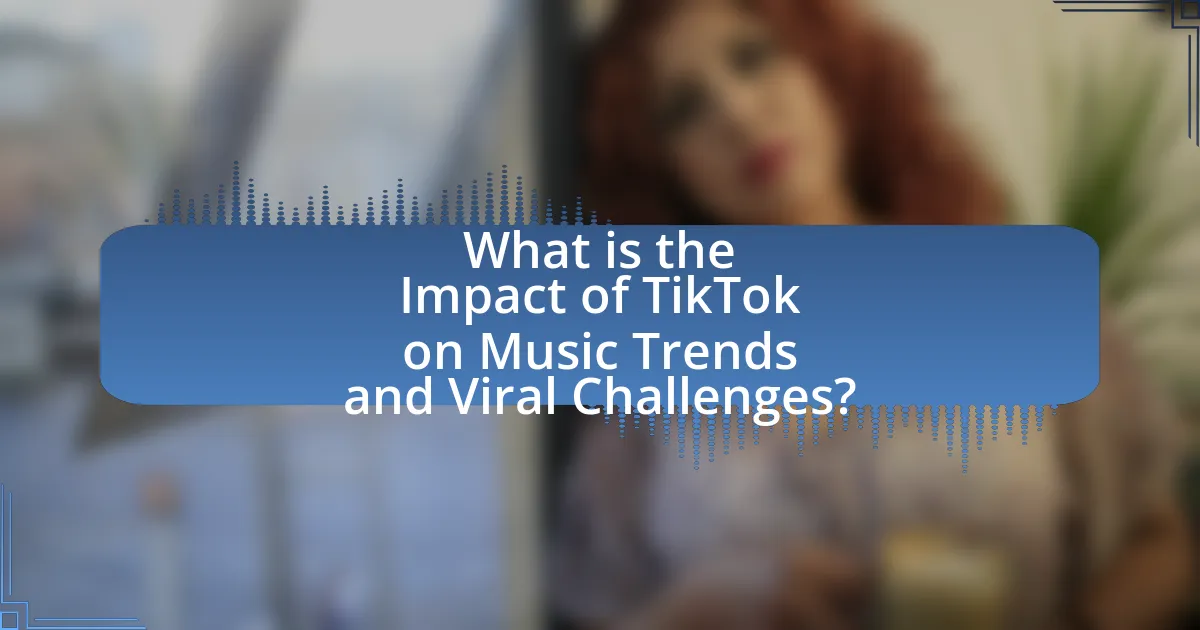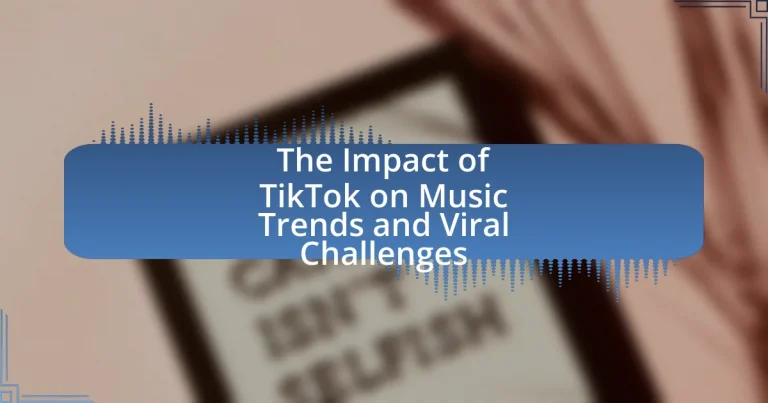TikTok has emerged as a powerful force in shaping music trends and viral challenges, significantly impacting how songs gain popularity and how artists promote their work. The platform’s algorithm enhances music discovery by personalizing content based on user interactions, leading to increased streaming and chart success for tracks associated with viral challenges. User-generated content plays a crucial role in amplifying song visibility, while viral challenges drive engagement and commercial success in the music industry. Emerging artists can leverage TikTok for exposure, although they face challenges related to algorithm preferences and content saturation. Overall, TikTok’s influence extends across various music genres, reshaping the landscape of contemporary music consumption and promotion.

What is the Impact of TikTok on Music Trends and Viral Challenges?
TikTok significantly influences music trends and viral challenges by rapidly popularizing songs and creating dance challenges that engage users. The platform’s algorithm promotes content based on user interaction, allowing tracks to gain traction quickly; for instance, songs like “Savage Love” by Jawsh 685 and Jason Derulo became hits largely due to their viral TikTok dances. Additionally, TikTok has transformed how artists promote their music, with many emerging artists gaining recognition through viral challenges, leading to chart success. According to a report by the music analytics firm Chartmetric, songs that trend on TikTok often see a substantial increase in streaming numbers, demonstrating the platform’s power in shaping contemporary music culture.
How has TikTok changed the way music is consumed?
TikTok has fundamentally transformed music consumption by enabling short, engaging clips that promote songs through viral trends and challenges. This platform allows users to discover new music quickly, as songs often gain popularity through user-generated content, leading to increased streaming and chart success. For instance, songs like “Savage Love” by Jawsh 685 and Jason Derulo saw significant boosts in popularity after going viral on TikTok, with the song reaching number one on the Billboard Hot 100 in 2020. Additionally, TikTok’s algorithm promotes music that resonates with users, creating a feedback loop where trending sounds influence mainstream music charts.
What role do algorithms play in music discovery on TikTok?
Algorithms on TikTok play a crucial role in music discovery by personalizing content for users based on their interactions and preferences. The platform’s algorithm analyzes user behavior, such as likes, shares, and watch time, to curate a tailored feed that prominently features trending songs and emerging artists. This targeted approach not only enhances user engagement but also significantly boosts the visibility of specific tracks, leading to viral trends. For instance, songs that gain traction through user-generated content, such as dance challenges, often see a marked increase in streaming numbers on platforms like Spotify and Apple Music, demonstrating the direct impact of TikTok’s algorithm on music consumption patterns.
How does user-generated content influence music popularity?
User-generated content significantly influences music popularity by amplifying exposure and engagement through platforms like TikTok. When users create and share videos featuring specific songs, they can lead to viral trends that increase a track’s visibility and streaming numbers. For instance, a study by the University of Southern California found that songs featured in TikTok videos experienced a 1,000% increase in streams on platforms like Spotify. This phenomenon demonstrates how user-generated content can transform lesser-known tracks into chart-topping hits, showcasing the power of social media in shaping music trends.
Why are viral challenges significant in the music industry?
Viral challenges are significant in the music industry because they drive engagement and exposure for songs, often leading to increased streaming and sales. For instance, tracks that become associated with popular challenges on platforms like TikTok can see a dramatic rise in their chart performance; a notable example is “Savage Love” by Jawsh 685 and Jason Derulo, which gained immense popularity through a viral dance challenge, resulting in it reaching number one on the Billboard Hot 100. This phenomenon illustrates how viral challenges can create a direct link between social media trends and commercial success in music.
What are some examples of successful viral challenges on TikTok?
Some examples of successful viral challenges on TikTok include the “Renegade” dance challenge, which was created by Jalaiah Harmon and gained massive popularity in 2020, leading to widespread participation from users and celebrities alike. Another notable challenge is the “Savage” challenge, associated with the song by Megan Thee Stallion, which went viral in early 2020, showcasing users performing a specific dance routine. Additionally, the “Blinding Lights” challenge, inspired by The Weeknd’s hit song, became a global phenomenon in late 2019 and early 2020, with users replicating a choreographed dance that emphasized the song’s catchy beat. These challenges not only boosted the visibility of the songs but also significantly impacted music trends on the platform.
How do these challenges affect artist visibility and engagement?
Challenges such as algorithm changes and content saturation on TikTok significantly reduce artist visibility and engagement. When algorithms prioritize certain types of content, emerging artists may struggle to reach their target audience, leading to decreased engagement metrics. For instance, a study by the University of Southern California found that only 10% of TikTok videos receive over 1,000 views, indicating that many artists’ efforts go unnoticed. Additionally, as more creators join the platform, the competition for attention intensifies, making it harder for individual artists to stand out. This saturation can lead to lower interaction rates, as users may become overwhelmed by the volume of content, ultimately diminishing the potential for meaningful engagement with artists.
What are the implications of TikTok for emerging artists?
TikTok significantly impacts emerging artists by providing a platform for viral exposure and audience engagement. The app’s algorithm promotes content based on user interaction rather than follower count, allowing new artists to reach millions quickly. For instance, songs like “Savage Love” by Jawsh 685 and Jason Derulo gained immense popularity through TikTok challenges, leading to chart-topping success. Additionally, TikTok enables artists to showcase their creativity through short videos, fostering a direct connection with fans and facilitating grassroots marketing. This democratization of music promotion has reshaped the industry, allowing diverse voices to emerge and thrive.
How can new artists leverage TikTok for exposure?
New artists can leverage TikTok for exposure by creating engaging and authentic content that resonates with the platform’s audience. By utilizing popular trends, challenges, and hashtags, artists can increase their visibility and reach a wider audience. For instance, songs that become associated with viral challenges often see a significant boost in streams and downloads; a study by the University of Southern California found that tracks featured in TikTok videos can experience a 1,000% increase in streaming numbers. Additionally, collaborating with influencers on TikTok can further amplify an artist’s reach, as influencers have established followings that trust their recommendations.
What challenges do emerging artists face on the platform?
Emerging artists face significant challenges on TikTok, primarily due to the platform’s algorithm favoring established creators and trends over new content. This results in limited visibility for new artists, making it difficult for them to gain traction and build an audience. Additionally, the fast-paced nature of TikTok trends requires artists to constantly produce engaging content, which can be overwhelming and may detract from their artistic development. Furthermore, the competitive landscape means that emerging artists must navigate a saturated market where originality can be overshadowed by viral trends, making it challenging to stand out.
How does TikTok influence music trends globally?
TikTok influences music trends globally by rapidly popularizing songs through user-generated content and viral challenges. The platform’s algorithm promotes catchy snippets of music, leading to increased streams and chart success for featured tracks. For instance, songs like “Savage Love” by Jawsh 685 and Jason Derulo gained significant traction after going viral on TikTok, resulting in a peak position of number one on the Billboard Hot 100. Additionally, TikTok’s ability to create trends around specific songs encourages artists to release music that aligns with the platform’s culture, further shaping the global music landscape.
What are the connections between TikTok trends and mainstream music charts?
TikTok trends significantly influence mainstream music charts by driving song popularity through viral challenges and user-generated content. For instance, tracks that become associated with popular TikTok dances often see a surge in streaming numbers and chart positions; a notable example is “Savage Love” by Jawsh 685 and Jason Derulo, which climbed to the top of the Billboard Hot 100 after going viral on TikTok. Additionally, data from Billboard indicates that songs trending on TikTok frequently enter the Hot 100, demonstrating a direct correlation between TikTok engagement and chart performance. This trend highlights how TikTok serves as a powerful platform for music discovery, impacting listener behavior and chart dynamics.
What specific genres have gained popularity through TikTok?
The specific genres that have gained popularity through TikTok include pop, hip-hop, and indie music. Pop music has seen a resurgence with tracks like “Savage Love” by Jawsh 685 and Jason Derulo going viral, while hip-hop has been propelled by songs such as “WAP” by Cardi B and Megan Thee Stallion, which became widely used in dance challenges. Additionally, indie music has gained traction, exemplified by tracks like “Roses” by SAINt JHN, which became popular through user-generated content. These trends illustrate TikTok’s significant influence on music consumption and promotion, as songs that trend on the platform often achieve commercial success, evidenced by Billboard chart placements and streaming increases following viral moments.
How has TikTok contributed to the rise of specific music genres?
TikTok has significantly contributed to the rise of specific music genres by providing a platform for viral challenges and trends that promote songs. The app’s algorithm favors catchy and engaging content, allowing snippets of songs to gain widespread popularity quickly. For instance, the resurgence of genres like pop-punk and hip-hop can be attributed to viral dances and challenges that feature these styles, leading to increased streaming and sales. A notable example is the song “Savage Love” by Jawsh 685 and Jason Derulo, which gained immense popularity through TikTok dances, resulting in it reaching the top of the Billboard charts. This demonstrates how TikTok not only introduces new music to a broader audience but also revitalizes older genres by integrating them into contemporary social media culture.
What are the characteristics of music that goes viral on TikTok?
Music that goes viral on TikTok typically features catchy hooks, relatable lyrics, and a strong beat. Catchy hooks are essential as they grab attention quickly, often leading to users creating short videos that highlight these memorable segments. Relatable lyrics resonate with a wide audience, allowing users to connect emotionally and share their experiences through the music. A strong beat facilitates easy dancing or movement, which is crucial for the platform’s video-centric nature.
Additionally, songs that are under 30 seconds long tend to perform better, as they fit the platform’s format and encourage repeat listening. The use of trending sounds or challenges also amplifies a song’s virality, as users are more likely to engage with music that is already popular within the community. According to a study by the University of Southern California, songs that align with these characteristics have a higher likelihood of being used in user-generated content, which significantly boosts their chances of going viral.
What strategies can artists use to succeed on TikTok?
Artists can succeed on TikTok by creating engaging, authentic content that resonates with their audience. This involves leveraging popular trends, utilizing hashtags effectively, and participating in challenges to increase visibility. Additionally, artists should collaborate with other creators to tap into new audiences and maintain a consistent posting schedule to keep followers engaged. According to a study by the University of Southern California, artists who engage with their audience through comments and live streams see a 30% increase in follower retention, highlighting the importance of interaction in building a loyal fan base.
How can artists create engaging content that resonates with TikTok users?
Artists can create engaging content that resonates with TikTok users by leveraging trends, utilizing popular sounds, and incorporating storytelling elements. Engaging content often aligns with current TikTok trends, which can be identified through the app’s Discover page, showcasing what is popular at any given moment. Additionally, using trending sounds or music clips can enhance visibility, as TikTok’s algorithm favors content that utilizes these elements. Storytelling, whether through humor, emotion, or relatable experiences, captivates viewers and encourages shares, further increasing engagement. According to a study by the University of Southern California, videos that tell a story are 22 times more likely to be shared than those that do not, highlighting the importance of narrative in content creation.
What are best practices for participating in viral challenges?
To effectively participate in viral challenges, individuals should prioritize authenticity, creativity, and engagement. Authenticity ensures that participants remain true to themselves, which resonates with audiences and fosters genuine connections. Creativity allows participants to stand out by adding unique twists to the challenge, increasing the likelihood of their content being shared. Engagement is crucial; actively interacting with viewers through comments and shares can enhance visibility and encourage community involvement.
Research indicates that content that reflects personal style and creativity tends to perform better on platforms like TikTok, where trends evolve rapidly. For instance, a study by the Pew Research Center found that 69% of TikTok users engage with challenges, highlighting the platform’s role in shaping user interaction and content virality.
How can brands effectively collaborate with TikTok influencers in music marketing?
Brands can effectively collaborate with TikTok influencers in music marketing by aligning their campaigns with the influencers’ authentic style and audience engagement. This involves selecting influencers whose content resonates with the brand’s target demographic, ensuring that the music featured in the campaign fits seamlessly into the influencer’s existing content. For instance, a study by the Digital Marketing Institute found that 63% of consumers trust influencers more than brands, highlighting the importance of authenticity in these collaborations. Additionally, brands should leverage TikTok’s unique features, such as challenges and trends, to create interactive content that encourages user participation, thereby amplifying reach and engagement.


